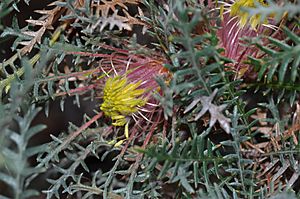Banksia serratuloides facts for kids
Quick facts for kids Banksia serratuloides |
|
|---|---|
 |
|
| Scientific classification | |
| Genus: |
Banksia
|
| Species: |
serratuloides
|
| Synonyms | |
|
|
Banksia serratuloides is a special type of small shrub. It grows only in Western Australia, meaning it is endemic to that area. This plant has long, narrow leaves that are deeply divided. Its flowers are yellow and pink and grow in clusters of about forty. After flowering, it produces hairy, wrinkled seed pods called follicles.
Contents
What Does Banksia serratuloides Look Like?
Banksia serratuloides is a shrub that usually grows to about 50 centimeters (about 20 inches) tall. It has a special woody base called a lignotuber. This helps the plant regrow after events like bushfires.
Its stems are a bit hairy. The leaves are long and thin, measuring 30 to 90 millimeters (about 1 to 3.5 inches) long and 7 to 15 millimeters (about 0.3 to 0.6 inches) wide. They grow on a short stalk called a petiole. Each side of the leaf has many triangular or spear-shaped parts, called lobes. The number of lobes can be different depending on the plant's type.
The flowers are very pretty. About 35 to 40 yellow flowers grow together in a cluster. At the bottom of each flower cluster, there are shiny brown, egg-shaped or spear-shaped leaves called bracts. These bracts are 11 to 25 millimeters (about 0.4 to 1 inch) long.
Each flower has a part called a perianth, which is pink at the bottom and measures 19 to 23 millimeters (about 0.7 to 0.9 inches) long. The pistil, which is the female part of the flower, is also pink and 22 to 29 millimeters (about 0.9 to 1.1 inches) long. This plant flowers from July to September. After the flowers, it forms oval-shaped seed pods called follicles. These pods are 5 to 6 millimeters (about 0.2 inches) long, wrinkled, and covered in dense hairs.
How Was Banksia serratuloides Named?
This plant was first officially described in 1855 by a scientist named Carl Meissner. He named it Dryandra serratuloides. His description was published in a science journal called Hooker's Journal of Botany and Kew Garden Miscellany. The plants he studied were collected by another botanist, James Drummond.
The second part of its name, serratuloides, means "like Serratula". This is because the plant's leaves look similar to those of plants in the Serratula genus.
In 1996, another botanist, Alex George, described two different types (subspecies) of this plant in the journal Nuytsia:
- Dryandra serratuloides subspecies perissa: This type has leaves with 6 to 12 lobes on each side. Its inner bracts are 11 to 20 millimeters long.
- Dryandra serratuloides subspecies serratuloides: This type has leaves with 20 to 33 lobes on each side. Its inner bracts are 22 to 25 millimeters long.
Later, in 2007, scientists Austin Mast and Kevin Thiele moved all Dryandra plants into the Banksia group. So, Dryandra serratuloides became Banksia serratuloides. The two subspecies were also renamed to B. serratuloides subspecies perissa and B. serratuloides subspecies serratuloides. These names are now officially accepted by the Australian Plant Census.
Where Does Banksia serratuloides Grow?
Banksia serratuloides grows in areas of kwongan (a type of shrubland) or open shrubland. It is found in two separate areas in Western Australia. These areas are located between Eneabba and Mogumber.
The subspecies perissa grows between Alexander Morrison National Park, Badgingarra, and Boothendarra Hill. The subspecies serratuloides is found near Gillingarra and Mogumber.
Is Banksia serratuloides Endangered?
The Western Australian Government's Department of Parks and Wildlife says that Banksia serratuloides as a whole is "not threatened." This means it is not currently at risk of disappearing.
However, both of its subspecies, perissa and serratuloides, are listed as "Threatened Flora (Declared Rare Flora — Extant)" by the Department of Environment and Conservation (Western Australia). This means these specific types of the plant are considered rare and need protection.

